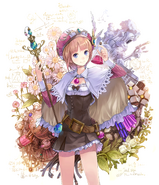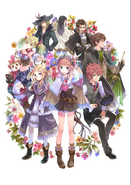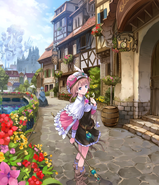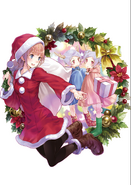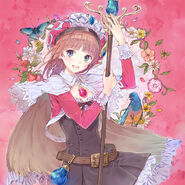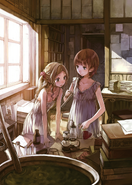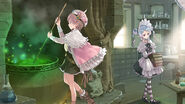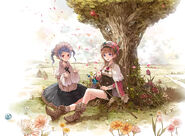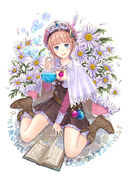Tag: Visual edit |
(→Arland) Tag: Visual edit |
||
| (One intermediate revision by the same user not shown) | |||
| Line 20: | Line 20: | ||
<sup>JP</sup> Gust<br><sup>NA</sup> NIS America |
<sup>JP</sup> Gust<br><sup>NA</sup> NIS America |
||
<br><sup>EU</sup> NIS Europe |
<br><sup>EU</sup> NIS Europe |
||
| − | <br>''' |
+ | <br>'''Atelier Rorona Plus''' |
<br><sup>JP</sup> Koei Tecmo Games |
<br><sup>JP</sup> Koei Tecmo Games |
||
<br><sup>NA</sup> Koei Tecmo America |
<br><sup>NA</sup> Koei Tecmo America |
||
<br><sup>EU</sup> Koei Tecmo Europe |
<br><sup>EU</sup> Koei Tecmo Europe |
||
| + | <br>'''New Atelier Rorona''' |
||
| + | <br><sup>JP</sup> Koei Tecmo Games |
||
<br>'''Atelier Rorona DX'''<br> |
<br>'''Atelier Rorona DX'''<br> |
||
<sup>JP</sup> Koei Tecmo Games<br> |
<sup>JP</sup> Koei Tecmo Games<br> |
||
|released = '''Atelier Rorona'''<br>[[File:Japan.gif]] June 25, 2009<br>[[File:America.gif]] September 28, 2010<br>[[File:Europe.gif]] October 22, 2010<br>'''Atelier Rorona Plus'''<br>[[File:Japan.gif]] November 21, 2013<br>[[File:America.gif]] June 24, 2014<br>[[File:Europe.gif]] June 20, 2014<br> |
|released = '''Atelier Rorona'''<br>[[File:Japan.gif]] June 25, 2009<br>[[File:America.gif]] September 28, 2010<br>[[File:Europe.gif]] October 22, 2010<br>'''Atelier Rorona Plus'''<br>[[File:Japan.gif]] November 21, 2013<br>[[File:America.gif]] June 24, 2014<br>[[File:Europe.gif]] June 20, 2014<br> |
||
| + | '''New Atelier Rorona'''<br>[[File:Japan.gif]] March 26, 2015<br> |
||
'''Atelier Rorona DX'''<br>[[File:Japan.gif]] September 20, 2018<br>[[File:America.gif]] December 4, 2018<br>[[File:Europe.gif]] December 4, 2018 |
'''Atelier Rorona DX'''<br>[[File:Japan.gif]] September 20, 2018<br>[[File:America.gif]] December 4, 2018<br>[[File:Europe.gif]] December 4, 2018 |
||
|modes = Offline <br> Single Player |
|modes = Offline <br> Single Player |
||
|ratings = [[File: CERO_A.png|20px]]{{W|Computer Entertainment Rating Organization|CERO}}: All ages (A) <br> [[File: ESRB_T.png|20px]]{{W|Entertainment Software Rating Board|ESRB}}: Teen (T) <br> [[File: PEGI_12.png|20px]]{{W|Pan European Game Information|PEGI}}: 12+<br> |
|ratings = [[File: CERO_A.png|20px]]{{W|Computer Entertainment Rating Organization|CERO}}: All ages (A) <br> [[File: ESRB_T.png|20px]]{{W|Entertainment Software Rating Board|ESRB}}: Teen (T) <br> [[File: PEGI_12.png|20px]]{{W|Pan European Game Information|PEGI}}: 12+<br> |
||
| − | [[File:USK_6.png|20px]]USK: Ages 6+<br>''' |
+ | [[File:USK_6.png|20px]]USK: Ages 6+<br>'''Atelier Rorona Plus'''<br>[[File: CERO_B.png|20px]]{{W|Computer Entertainment Rating Organization|CERO}}: Ages 12+ (B)<br> [[File: ESRB_T.png|20px]]{{W|Entertainment Software Rating Board|ESRB}}: Teen (T) <br> [[File: PEGI_12.png|20px]]{{W|Pan European Game Information|PEGI}}: 12+<br> |
| + | [[File:USK_6.png|20px]]USK: Ages 6+<br> |
||
| ⚫ | |||
| + | '''New Atelier Rorona'''<br>[[File: CERO_B.png|20px]]{{W|Computer Entertainment Rating Organization|CERO}}: Ages 12+ (B)<br> |
||
| ⚫ | |||
| + | '''Atelier Rorona DX'''<br>[[File: CERO_B.png|20px]]{{W|Computer Entertainment Rating Organization|CERO}}: Ages 12+ (B)<br> [[File: ESRB_T.png|20px]]{{W|Entertainment Software Rating Board|ESRB}}: Teen (T) <br> [[File: PEGI_12.png|20px]]{{W|Pan European Game Information|PEGI}}: 12+<br> |
||
| − | |||
| + | [[File:USK_12.png|20px]]USK: Ages 12+<br> |
||
| − | It is the first game in the Arland series, and the prequel to the next game in the series,'' [[Atelier Totori: The Adventurer of Arland]].'' Many of the game's characters and locations are a new addition to the Atelier series, and carry on through to future releases within the Arland Series. |
||
| ⚫ | |||
| + | '''New Atelier Rorona'''<br>{{W|Nintendo 3DS}}<br> |
||
| + | '''Atelier Rorona DX'''<br>{{W|PlayStation 4}}<br>{{W|Nintendo Switch}}<br>{{W|Steam}} |
||
| ⚫ | |genre = Role Playing Game}}'''Atelier Rorona: The Alchemist of Arland''' (ロロナのアトリエ ~アーランドの錬金術士~, ''Rorona no Atorie ~Aarando no Renkinjutsushi~'') is the 11th core ''Atelier'' title and the first on the PlayStation 3. It is known by the project code ''' "A11" '''. It is the first game in the Arland series and is followed by'' [[Atelier Totori: The Adventurer of Arland]] ''and several of the locations depicted in this title would appear in future Arland games. ''Atelier Rorona'' is also the first game in the ''Atelier'' franchise to feature 3D models instead of 2D sprites. |
||
| + | A remake of the game for the Playstation 3 and Playstation Vita was released under the name ''Atelier Rorona Plus'' (新・ロロナのアトリエ はじまりの物語~アーランドの錬金術士~, ''Shin Rorona no Atorie Hajimari no Monogatari ~Aarando no Renkinjutsushi~'') on November 21, 2013 in Japan, on June 24 2014 in the US, and on June 20, 2014 in Europe. |
||
| − | ''Atelier Rorona'' is also the first game in the series to feature 3D models instead of sprites. |
||
| − | A remake |
+ | A second full remake for the Nintendo 3DS, released under the title of ''New Atelier Plus ''(新・ロロナのアトリエ はじまりの物語~アーランドの錬金術士~, ''Shin Rorona no Atorie Hajimari no Monogatari ~Aarando no Renkinjutsushi~'')'', ''was released on March 26, 2015 in Japan only. |
A port of the game under the name ''Atelier Rorona DX'' released September 20th, 2018 in Japan for the PlayStation 4 and Nintendo Switch and December 4th, 2018 in the rest of the world, with an additional Steam release worldwide.<ref>http://ps3dominater.com/blog-entry-7257.html</ref> |
A port of the game under the name ''Atelier Rorona DX'' released September 20th, 2018 in Japan for the PlayStation 4 and Nintendo Switch and December 4th, 2018 in the rest of the world, with an additional Steam release worldwide.<ref>http://ps3dominater.com/blog-entry-7257.html</ref> |
||
| Line 53: | Line 60: | ||
===Workshop=== |
===Workshop=== |
||
| − | The workshop is where Rorona performs synthesis— creating new items from other ingredients. To synthesize an item, you must first know the recipe for it, which is often contained in a book. Alchemy books are usually bought from stores in town, however some are given to you during the plot |
+ | The workshop is where Rorona performs synthesis— creating new items from other ingredients. To synthesize an item, you must first know the recipe for it, which is often contained in a book. Alchemy books are usually bought from stores in town, however some are given to you during the plot while others are found in various dungeons. |
Ingredients for synthesis may be stored either in Rorona's basket, which holds 60 items, or in the container, which holds 999 items. The basket, while limited in size, allows Rorona to carry items with her around town or to dungeons; the container always remains at the workshop. |
Ingredients for synthesis may be stored either in Rorona's basket, which holds 60 items, or in the container, which holds 999 items. The basket, while limited in size, allows Rorona to carry items with her around town or to dungeons; the container always remains at the workshop. |
||
| − | When items are synthesized, days are added to your calendar, moving you closer to the examination day, and Rorona loses some MP. However, you also gain synthesis experience. Once you have gained enough experience your Alchemy level will increase, allowing you to make more complex items. |
+ | When items are synthesized, days are added to your calendar, moving you closer to the examination day, and Rorona loses some HP (MP in Plus/DX). However, you also gain synthesis experience. Once you have gained enough experience your Alchemy level will increase, allowing you to make more complex items. |
===Arland=== |
===Arland=== |
||
| Line 63: | Line 70: | ||
Rorona can travel around the town of Arland by means of a map with several locations in the city on it including shops, the town square, the palace, etc. In each location, Rorona can interact with various NPCs (and playable characters). |
Rorona can travel around the town of Arland by means of a map with several locations in the city on it including shops, the town square, the palace, etc. In each location, Rorona can interact with various NPCs (and playable characters). |
||
| − | At the palace |
+ | At the palace Rorona has access to the Front Desk and the Palace Hallway. Esty runs the front desk and gives out quests from the townspeople. By completing these tasks you can rebuild the Atelier's credibility. Later in the game, additional requirements are added to the requests, which can allow Rorona to earn tickets that can be traded for items, as well. The Palace Hallway is where Sterk is located and Rorona can turn in items for the Assignments. |
| − | The town also contains three (later four) shops: Sunrise Cafe, Beefy Weapon Shop, and R&T Sundries. Sunrise Cafe carries cooking ingredients, which can be used to synthesize food. Beefy Weapon Shop carries various mineral ingredients |
+ | The town also contains three (later four) shops: Sunrise Cafe, Beefy Weapon Shop, and R&T Sundries. Sunrise Cafe carries cooking ingredients, which can be used to synthesize food. Beefy Weapon Shop carries various mineral ingredients and allows you to order weapons and armor for your characters. R&T Sundries carries various ingredients that can be used for synthesis. Later, by triggering certain events, you can unlock a fourth shop carrying various magical items. As the game progresses, you will be able to use a feature called wholesale. Wholesale allows you to register items you have synthesized to shops, so that they can now sell these items. This allows you to save time by purchasing ingredients or other items rather than having to synthesize them. |
Certain NPCs in town have the ability to request items from you (similar to requests from the palace). However, instead of increasing trust, these increase your friendship with that NPC. By increasing friendship you can unlock scenes with these characters, as well as gaining other benefits. |
Certain NPCs in town have the ability to request items from you (similar to requests from the palace). However, instead of increasing trust, these increase your friendship with that NPC. By increasing friendship you can unlock scenes with these characters, as well as gaining other benefits. |
||
| Line 76: | Line 83: | ||
Locations outside of town are also filled with monsters— it's while adventuring that this game shows elements of traditional JRPGs. Just as each new locations takes more time to travel to, each new location will contain stronger monsters to battle. However, battling monsters gives adventurer experience. Once you gain enough experience, your characters' adventurer level will increase, which increases battle statistics and grants new skills. |
Locations outside of town are also filled with monsters— it's while adventuring that this game shows elements of traditional JRPGs. Just as each new locations takes more time to travel to, each new location will contain stronger monsters to battle. However, battling monsters gives adventurer experience. Once you gain enough experience, your characters' adventurer level will increase, which increases battle statistics and grants new skills. |
||
| − | The battle system is turn based, with turn order determined by the characters' speed statistic. During a characters turn, the player may attack, use a skill, defend, or attempt to escape. Rorona (who must always be in the party) also has the option of using items from the basket. To use a skill (which may be stronger attacks or healing move), the character must expend HP, rather than a separate "MP" statistic. Additionally, guarding halves all damage taken from enemies. These mechanics make it necessary to think strategically about battles. If a character is reduced to 0 HP, they are knocked out, but can be revived with certain healing items. If all characters are knocked out, rather than receiving a game over the player is immediately returned to the workshop |
+ | The battle system is turn based, with turn order determined by the characters' speed statistic. During a characters turn, the player may attack, use a skill, defend, or attempt to escape. Rorona (who must always be in the party) also has the option of using items from the basket. To use a skill (which may be stronger attacks or healing move), the character must expend HP, rather than a separate "MP" statistic (this is changed in the Plus/DX version). Additionally, guarding halves all damage taken from enemies. These mechanics make it necessary to think strategically about battles. If a character is reduced to 0 HP, they are knocked out, but can be revived with certain healing items. If all characters are knocked out, rather than receiving a game over, the player is immediately returned to the workshop with days subtracted from their calendar. Characters are revived at 1 HP. |
===Completing Assignments=== |
===Completing Assignments=== |
||
| − | Each assignment is clearly spelled out at the beginning of the 90 day period, specifically stating what items can be turned in. In addition to this, there may be additional requirements, such as turning in items of high quality or turning items with strong effects, etc. As you report these items to Sterk, you will receive small golden stars (which can be viewed in the status menu). You can receive 10 such stars, which determine how well you have completed each assignment. Depending on how many of these stars you receive you may receive |
+ | Each assignment is clearly spelled out at the beginning of the 90 day period, specifically stating what items can be turned in. In addition to this, there may be additional requirements, such as turning in items of high quality or turning items with strong effects, etc. As you report these items to Sterk, you will receive small golden stars (which can be viewed in the status menu). You can receive 10 such stars, which determine how well you have completed each assignment. Depending on how many of these stars you receive you may receive one of the game's multiple endings. If at any point during the game you fail to complete an assignment, you will receive a game over. |
===Endings=== |
===Endings=== |
||
| − | Depending on how you count the game has four main endings with ten additional endings. The four main endings are obtained based on your performance in completing assignments and the level of trust you gained through job requests. The additional endings are determined based on the completion of certain in game tasks. Among these additional endings are character specific endings, which require the activation of flag events. |
+ | Depending on how you count the game has four main endings with ten additional endings. The four main endings are obtained based on your performance in completing assignments and the level of trust you gained through job requests. The additional endings are determined based on the completion of certain in game tasks. Among these additional endings are character specific endings, which require the activation of flag events. On completion of Year 3, an ending will play based on the requirements you cleared and chosen by priority. |
=='''Characters'''== |
=='''Characters'''== |
||
| Line 113: | Line 120: | ||
===Age Discrepancy=== |
===Age Discrepancy=== |
||
| − | The North American version of ''Atelier Rorona'' was released with the ages of several characters changed, which causes a change in the time between ''Atelier Rorona'' and it's sequel ''[[Atelier Totori: The Adventurer of Arland]]'' |
+ | The North American version of ''Atelier Rorona'' was released with the ages of several characters changed, which causes a change in the time between ''Atelier Rorona'' and it's sequel ''[[Atelier Totori: The Adventurer of Arland]]'' and also changes the age of several characters in between the two versions. Their decision was eventually called a {{W|retcon}}and is not considered to be an official change to the series. However, ''Atelier Meruru'' maintains the original ages of all characters new and old. |
For all intents and purposes, both ages will be listed for characters that appear in ''Atelier Rorona'' and in ''Atelier Totori''. This is to avoid confusion for those players who are not aware of this issue. |
For all intents and purposes, both ages will be listed for characters that appear in ''Atelier Rorona'' and in ''Atelier Totori''. This is to avoid confusion for those players who are not aware of this issue. |
||
=='''Development'''== |
=='''Development'''== |
||
| − | Much of the staff responsible for the development was also involved in the development of the ''Atelier Iris'' trilogy. The scenario was written by Toshiyuki Suzuki (writer for ''[[Atelier Iris 3: Grand Phantasm|Atelier Iris 3]]''). Art direction was by Yasuhiro Nakagawa |
+ | Much of the staff responsible for the development was also involved in the development of the ''Atelier Iris'' trilogy. The scenario was written by Toshiyuki Suzuki (writer for ''[[Atelier Iris 3: Grand Phantasm|Atelier Iris 3]]''). Art direction was by Yasuhiro Nakagawa and character design was done by Mel Kishida. Kishida also provided the in-game character illustration. Music for the game was composed by Ken Nakagawa, composer of the soundtracks of games in the series since Atelier Viorate. |
Localization for Atelier Rorona was handled by NIS America and NIS Europe. Voice recording for the English version of the game was done by BangZoom! Entertainment. |
Localization for Atelier Rorona was handled by NIS America and NIS Europe. Voice recording for the English version of the game was done by BangZoom! Entertainment. |
||
=='''Atelier Rorona Plus'''== |
=='''Atelier Rorona Plus'''== |
||
| − | A remake of the game under the name 新・ロロナのアトリエ はじまりの物語~アーランドの錬金術士~(''Shin Rorona no Atorie Hajimari no Monogatari ~Aarando no Renkinjutsushi~'') was released for PlayStation 3 and PlayStation Vita in Japan in November 2013 in both a standard edition and a "Premium Box" edition. The game supports Cross-Save between the two consoles |
+ | A remake of the game under the name 新・ロロナのアトリエ はじまりの物語~アーランドの錬金術士~(''Shin Rorona no Atorie Hajimari no Monogatari ~Aarando no Renkinjutsushi~'') was released for PlayStation 3 and PlayStation Vita in Japan in November 2013 in both a standard edition and a "Premium Box" edition. The game supports Cross-Save between the two consoles and the PS Vita version is compatible with the PlayStation Vita TV as well. ''Atelier Rorona Plus'' received a higher {{W|Computer Entertainment Rating Organization|CERO}}rating than the original ''Atelier Rorona''. First press copies of the game came with a download code for an additional swimsuit costume called Peach Vacation. |
| − | The PS3 version and PS Vita version differ in content by what bonuses that can be obtained from save |
+ | The PS3 version and PS Vita version differ in content by what bonuses that can be obtained from save data of previously released ''Atelier'' titles and that the PS3 version's art gallery in the extra section contains additional artwork that were featured in the galleries of ''Atelier Meruru Plus'' and ''Atelier Totori Plus. ''The "Premium Box" editions of the game also differs slightly in content between the PS3 and PS Vita versions. |
The PS3 and Vita English localisations, released as ''Atelier Rorona Plus'', were released in North America and Europe in June 2014. |
The PS3 and Vita English localisations, released as ''Atelier Rorona Plus'', were released in North America and Europe in June 2014. |
||
| Line 177: | Line 184: | ||
==== Hom ==== |
==== Hom ==== |
||
| − | Hom is now leveled up through completing lines on the bingo card instead of through working, meaning the player must now achieve a certain amount of the optional goals in time in order to continue leveling them up. |
+ | Hom is now leveled up through completing lines on the bingo card instead of through working, meaning the player must now achieve a certain amount of the optional goals in time in order to continue leveling them up. Hom can reach a max level 5 in Synthesis and Gathering. |
| − | == '''Atelier Rorona |
+ | == '''New''' '''Atelier Rorona ''' == |
| − | + | A second remake of the game for the Nintendo 3DS was released in Japan on March 26, 2015. The game features a new chibi art style and a new battle system. The base game content is the same as Atelier Rorona Plus on other platforms. |
|
An additional mode called Atelier Astrid becomes available from the main menu in year 3 after reaching Friend Level 60 with Sterk and defeating [[Suni Sterm]]. <ref>http://bozumemo.blogspot.com/2015/06/blog-post_5.html</ref> The mode is a prequel to Atelier Rorona focusing on the time Astrid cured an illness affecting Rorona's parents. |
An additional mode called Atelier Astrid becomes available from the main menu in year 3 after reaching Friend Level 60 with Sterk and defeating [[Suni Sterm]]. <ref>http://bozumemo.blogspot.com/2015/06/blog-post_5.html</ref> The mode is a prequel to Atelier Rorona focusing on the time Astrid cured an illness affecting Rorona's parents. |
||
Revision as of 17:44, 7 January 2020
Atelier Rorona: The Alchemist of Arland (ロロナのアトリエ ~アーランドの錬金術士~, Rorona no Atorie ~Aarando no Renkinjutsushi~) is the 11th core Atelier title and the first on the PlayStation 3. It is known by the project code "A11" . It is the first game in the Arland series and is followed by Atelier Totori: The Adventurer of Arland and several of the locations depicted in this title would appear in future Arland games. Atelier Rorona is also the first game in the Atelier franchise to feature 3D models instead of 2D sprites.
A remake of the game for the Playstation 3 and Playstation Vita was released under the name Atelier Rorona Plus (新・ロロナのアトリエ はじまりの物語~アーランドの錬金術士~, Shin Rorona no Atorie Hajimari no Monogatari ~Aarando no Renkinjutsushi~) on November 21, 2013 in Japan, on June 24 2014 in the US, and on June 20, 2014 in Europe.
A second full remake for the Nintendo 3DS, released under the title of New Atelier Plus (新・ロロナのアトリエ はじまりの物語~アーランドの錬金術士~, Shin Rorona no Atorie Hajimari no Monogatari ~Aarando no Renkinjutsushi~), was released on March 26, 2015 in Japan only.
A port of the game under the name Atelier Rorona DX released September 20th, 2018 in Japan for the PlayStation 4 and Nintendo Switch and December 4th, 2018 in the rest of the world, with an additional Steam release worldwide.[1]
Plot
The game opens with a brief introduction to the city of Arland, a city that is slowly being industrialized, but also a city that uses technology possessed by an ancient civilization. We are then introduced to the main character, Rorolina Frixell (Rorona, for short), who is forced to work for a master alchemist (Astrid Zexis) to pay off a debt her parents owe.
One day, Sterkenburg Cranach (Sterk, for short), a knight of Arland, comes to the alchemy workshop and informs Rorona that the shop will be shut down, unless she is able to prove that it can function in the city's economy. Over the next three years, she must pass 12 examinations to assess the ability of the workshop to do this.
Gameplay
Gameplay in Atelier Rorona consists of three parts: working in the alchemy workshop, running errands in Arland, and adventuring outside of town. The primary feature of this game (as with other installments of the series) is time management. The game takes place over a period of three years, which is broken up into twelve assignments. With the exception of two of these, each assignment lasts 90 days (89 plus an evaluation day). The remaining days are spent on two annual festivals, lasting 10 days each.
Workshop
The workshop is where Rorona performs synthesis— creating new items from other ingredients. To synthesize an item, you must first know the recipe for it, which is often contained in a book. Alchemy books are usually bought from stores in town, however some are given to you during the plot while others are found in various dungeons.
Ingredients for synthesis may be stored either in Rorona's basket, which holds 60 items, or in the container, which holds 999 items. The basket, while limited in size, allows Rorona to carry items with her around town or to dungeons; the container always remains at the workshop.
When items are synthesized, days are added to your calendar, moving you closer to the examination day, and Rorona loses some HP (MP in Plus/DX). However, you also gain synthesis experience. Once you have gained enough experience your Alchemy level will increase, allowing you to make more complex items.
Arland
Rorona can travel around the town of Arland by means of a map with several locations in the city on it including shops, the town square, the palace, etc. In each location, Rorona can interact with various NPCs (and playable characters).
At the palace Rorona has access to the Front Desk and the Palace Hallway. Esty runs the front desk and gives out quests from the townspeople. By completing these tasks you can rebuild the Atelier's credibility. Later in the game, additional requirements are added to the requests, which can allow Rorona to earn tickets that can be traded for items, as well. The Palace Hallway is where Sterk is located and Rorona can turn in items for the Assignments.
The town also contains three (later four) shops: Sunrise Cafe, Beefy Weapon Shop, and R&T Sundries. Sunrise Cafe carries cooking ingredients, which can be used to synthesize food. Beefy Weapon Shop carries various mineral ingredients and allows you to order weapons and armor for your characters. R&T Sundries carries various ingredients that can be used for synthesis. Later, by triggering certain events, you can unlock a fourth shop carrying various magical items. As the game progresses, you will be able to use a feature called wholesale. Wholesale allows you to register items you have synthesized to shops, so that they can now sell these items. This allows you to save time by purchasing ingredients or other items rather than having to synthesize them.
Certain NPCs in town have the ability to request items from you (similar to requests from the palace). However, instead of increasing trust, these increase your friendship with that NPC. By increasing friendship you can unlock scenes with these characters, as well as gaining other benefits.
Adventuring
Occasionally, it will be necessary to travel outside to gather ingredients or to complete certain other tasks. Traveling around to different locations adds a days to the calendar, both on the way there and the way back. The earliest locations in the game take only a few days, but later locations can take up to 7 days to travel to.
While exploring an area in a location, search points will appear on the map. These points contain synthesis items, which may be moved to the basket. These search points are marked with a blue star; however, search points marked with a gold star occasionally appear. These search points contain higher quality ingredients than found at normal search points.
Locations outside of town are also filled with monsters— it's while adventuring that this game shows elements of traditional JRPGs. Just as each new locations takes more time to travel to, each new location will contain stronger monsters to battle. However, battling monsters gives adventurer experience. Once you gain enough experience, your characters' adventurer level will increase, which increases battle statistics and grants new skills.
The battle system is turn based, with turn order determined by the characters' speed statistic. During a characters turn, the player may attack, use a skill, defend, or attempt to escape. Rorona (who must always be in the party) also has the option of using items from the basket. To use a skill (which may be stronger attacks or healing move), the character must expend HP, rather than a separate "MP" statistic (this is changed in the Plus/DX version). Additionally, guarding halves all damage taken from enemies. These mechanics make it necessary to think strategically about battles. If a character is reduced to 0 HP, they are knocked out, but can be revived with certain healing items. If all characters are knocked out, rather than receiving a game over, the player is immediately returned to the workshop with days subtracted from their calendar. Characters are revived at 1 HP.
Completing Assignments
Each assignment is clearly spelled out at the beginning of the 90 day period, specifically stating what items can be turned in. In addition to this, there may be additional requirements, such as turning in items of high quality or turning items with strong effects, etc. As you report these items to Sterk, you will receive small golden stars (which can be viewed in the status menu). You can receive 10 such stars, which determine how well you have completed each assignment. Depending on how many of these stars you receive you may receive one of the game's multiple endings. If at any point during the game you fail to complete an assignment, you will receive a game over.
Endings
Depending on how you count the game has four main endings with ten additional endings. The four main endings are obtained based on your performance in completing assignments and the level of trust you gained through job requests. The additional endings are determined based on the completion of certain in game tasks. Among these additional endings are character specific endings, which require the activation of flag events. On completion of Year 3, an ending will play based on the requirements you cleared and chosen by priority.
Characters
- Main article: List of Characters in Atelier Rorona
| ||||||||
Age Discrepancy
The North American version of Atelier Rorona was released with the ages of several characters changed, which causes a change in the time between Atelier Rorona and it's sequel Atelier Totori: The Adventurer of Arland and also changes the age of several characters in between the two versions. Their decision was eventually called a retcon and is not considered to be an official change to the series. However, Atelier Meruru maintains the original ages of all characters new and old.
For all intents and purposes, both ages will be listed for characters that appear in Atelier Rorona and in Atelier Totori. This is to avoid confusion for those players who are not aware of this issue.
Development
Much of the staff responsible for the development was also involved in the development of the Atelier Iris trilogy. The scenario was written by Toshiyuki Suzuki (writer for Atelier Iris 3). Art direction was by Yasuhiro Nakagawa and character design was done by Mel Kishida. Kishida also provided the in-game character illustration. Music for the game was composed by Ken Nakagawa, composer of the soundtracks of games in the series since Atelier Viorate.
Localization for Atelier Rorona was handled by NIS America and NIS Europe. Voice recording for the English version of the game was done by BangZoom! Entertainment.
Atelier Rorona Plus
A remake of the game under the name 新・ロロナのアトリエ はじまりの物語~アーランドの錬金術士~(Shin Rorona no Atorie Hajimari no Monogatari ~Aarando no Renkinjutsushi~) was released for PlayStation 3 and PlayStation Vita in Japan in November 2013 in both a standard edition and a "Premium Box" edition. The game supports Cross-Save between the two consoles and the PS Vita version is compatible with the PlayStation Vita TV as well. Atelier Rorona Plus received a higher CERO rating than the original Atelier Rorona. First press copies of the game came with a download code for an additional swimsuit costume called Peach Vacation.
The PS3 version and PS Vita version differ in content by what bonuses that can be obtained from save data of previously released Atelier titles and that the PS3 version's art gallery in the extra section contains additional artwork that were featured in the galleries of Atelier Meruru Plus and Atelier Totori Plus. The "Premium Box" editions of the game also differs slightly in content between the PS3 and PS Vita versions.
The PS3 and Vita English localisations, released as Atelier Rorona Plus, were released in North America and Europe in June 2014.
New Features
Atelier Rorona Plus includes several new features that were not present in or have been changed from the original Atelier Rorona.
Revamped Graphics
The 3D models of the characters have been revamped in Atelier Rorona Plus. The work on the character models was supervised by Mel Kishida and the models now better resemble his artwork. Field maps were also reworked, in many cases expanding the size of gathering areas as well as improving the visual quality of the models. The game's UI has been completely rebuilt.
Overtime
After the main game has been completed and the chosen ending viewed, the game now continues into an additional year called "Overtime". Overtime includes a new storyline featuring the protagonists from Atelier Meruru and Atelier Totori as well as additional events, CGs, and new dungeons. However, as the game is still considered over after the end of Year 3, additional character flags and wholesale shops cannot be unlocked in Overtime. The adventurer level cap is raised from 50 to 99 after Year 3 is completed and the player can use the extra year to prepare for a new playthrough that carries over into future games.
New Playable Characters
- Astrid Zexis
- Esty Dee
- Totooria "Totori" Helmold (Overtime)
- Merurulince "Meruru" Rede Arls (Overtime)
New Dungeons
Two new dungeons are added, accessible in Overtime:
- A new version of Liechtein Soehnle from Atelier Totori: The Adventurer of Arland appears as "Abyss Tower" which also has underwater areas.
- A new version of Machina Domain, a DLC dungeon from Atelier Meruru: The Apprentice of Arland.
- Orthogalaxen has additional areas open up to help grind for the top level dungeons added in Overtime.
Garden
A garden is now present in front of the atelier, allowing the player to grow synthesis ingredients. The player can now synthesize seeds for the garden to pass on desired quality and traits to the harvested items.
Time Capsule
The Time Capsule system becomes available in Overtime. By putting items inside a time capsule, they will change into a different item from "the future". Save data from Atelier Totori and Atelier Meruru will alter the items that come from the capsule.
Workshop Decorating
Special items are now used to decorate the workshop instead of being carried in the basket.
Costumes
Like in Atelier Meruru Plus and Atelier Totori Plus, the player will be able to change Rorona's and some of her friends costumes. Totori, Meruru, Cordelia, Sterkenburg, and Lionela have alternative costumes.
Event Updates
A new character ending for Esty is added. Events that went unvoiced have been fully dubbed in the Plus release. In addition, all character flags can be achieved in a single playthrough and the player will choose which ending they want to see at the end of Year 3. This allows for all ending trophies to be attained in one playthrough.
Gameplay Changes
HP and MP
Unlike the original game, Rorona now has MP in addition to HP. Item synthesis and battle skills now drain MP instead of HP as in the original. Rorona's MP is restored through resting or eventually through crafting MP restoration items, though HP and MP for party members besides Rorona is restored simply by time passing.
Battle
Atelier Rorona Plus features a new battle system based on Atelier Meruru Plus, as well as a version of the support skill system from Atelier Escha & Logy: Alchemists of the Dusk Sky. Playable characters now have 3 skills instead of 2 in additional to their new support skills. Sterk's moveset is taken from Atelier Meruru.
Synthesis
The synthesis system has been completely redone to a new one based on Atelier Meruru Plus with some small elements from Atelier Ayesha: The Alchemist of Dusk. The player will be allowed to choose from the available traits for the item, as long as the traits are affordable within the "Cost Level" of the item. Two traits can also combine into one single trait with higher effect. In addition, the player cannot assign unusable traits to an item anymore and the traits list has been pared down to remove useless and unhelpful traits. Some additional items have been added to the synthesis list.
Assignments
Every assignment from the kingdom in Atelier Rorona Plus now consists of one main goal that is necessary to fulfill along with several minor optional goals. A bingo card system similar to that in Atelier Escha & Logy: Alchemists of the Dusk Sky has been implemented for providing rewards for clearing the additional goals. For every additional assignment completed, a stamp is placed in one square of a bingo board with nine squares. Fulfilling the main assignment will place a stamp in the square in the middle of the board. Once three marks make up a vertical, horizontal, or diagonal line, the player will be rewarded with a bonus, such as recipes, stat increases, or vouchers to use in Esty's item exchange. Unlike in Atelier Escha & Logy, completing the additional goals is not counted as part of Rorona's evaluation and they do not impact endings.
In addition, Assignment 10 has been re-balanced to be easier to complete as the player now has multiple gathering nodes that provide the coral.
Quests and Vouchers
All quests, including character quests, are now managed by Esty and reported at her desk. Eventually the option to complete bonus requirements opens up - clearing these bonus objectives earns the player additional vouchers to use in Esty's new item exchange. Completing special requests for Esty herself will update the selection of items purchasable by vouchers and also open her up as a hireable party member.
Hom
Hom is now leveled up through completing lines on the bingo card instead of through working, meaning the player must now achieve a certain amount of the optional goals in time in order to continue leveling them up. Hom can reach a max level 5 in Synthesis and Gathering.
New Atelier Rorona
A second remake of the game for the Nintendo 3DS was released in Japan on March 26, 2015. The game features a new chibi art style and a new battle system. The base game content is the same as Atelier Rorona Plus on other platforms.
An additional mode called Atelier Astrid becomes available from the main menu in year 3 after reaching Friend Level 60 with Sterk and defeating Suni Sterm. [2] The mode is a prequel to Atelier Rorona focusing on the time Astrid cured an illness affecting Rorona's parents.
Atelier Rorona DX
A port of Atelier Rorona Plus for Nintendo Switch, PlayStation 4, and PC (via Steam) titled Atelier Rorona DX, was released September 20th, 2018 in Japan and December 4th, 2018 in the rest of the world. The PC port was released on the same day as the global console releases.
The DX version was almost unchanged from Plus and does not include any content from the 3DS version. However, it added the Peach Vacation costume that was previously unobtainable without a pre-order code and the ability to dash on the field maps.
Gallery
External links
References
| Atelier Rorona ~The Alchemist of Arland~ |
|---|
| Characters |
| Playable characters |
| Rorolina Frixell • Cordelia von Feuerbach • Iksel Jahnn • Lionela Heinze • Ludwig Giovanni Arland • Sterkenburg Cranach • Tantris • Astrid Zexis (Rorona Plus) • Esty Dee (Rorona Plus) • Merurulince Rede Arls (Rorona Plus) • Totori (Rorona Plus) |
| Shop Owners |
| Tiffani Hildebrand - Hagel Boldness - Iksel Jahnn - Pamela Ibis |
| Others |
| Hom - Meredith Alcock - Cole Dueller - Aranya and Horoholo - Ryan Frixell - Laura Frixell |
| Gameplay |
| Endings |
| Cordelia - Lionela - Iksel - Sterk - Tantris - Gio |
| Maps |
| Nearby Forest - Ortoga Ruins - National Mines - Traveler's Way - Catacombs - Ster Highlands - Nabel Lake - Dark Woods - Lost City - Orthogalaxen - Night's Domain |
| Quests |
| Assignments - Front Quests - Friend Quests |
| Data |
| Trophies - Weapons - Armors - Materials - Consumables - Synthesis Items - Key Items - Recipes - Shops - Monsters - Traits - Effects - CG Set |
| Merchandise |
| Original Soundtrack |
| ||||||||||||||||||||||||||||||||

